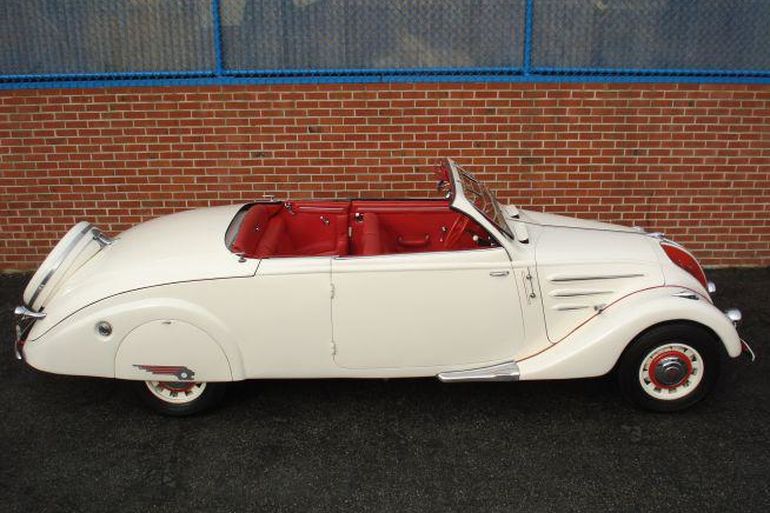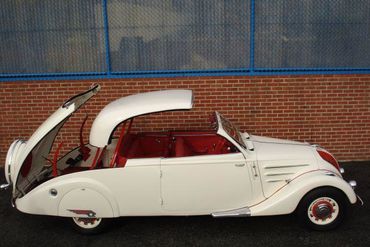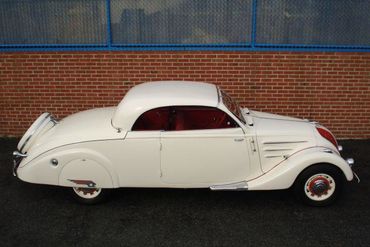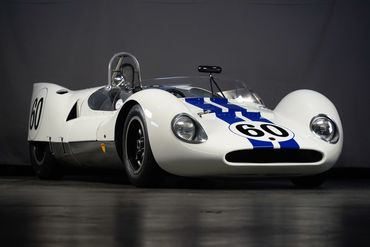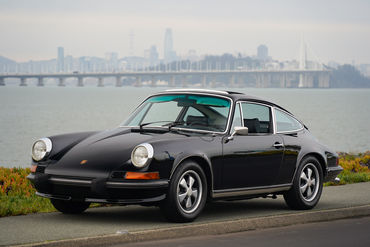Sold
SOLD 01/11
1938 Peugeot
402BL Eclipse Decapotable
See New Pricing!!! Incredible Streamline French Deco Styling by Paulin.
- VIN272535
- Exterior ColorEggshell White
- Interior ColorRed Leather
- Mileage8268 Miles
- Engine2148CC OHV Four-Cylinder Engine
- Engine no.806805
- Transmission3-Speed Manual
- StatusSold
- StockFJ952
Description
1938 PEUGEOT 402BL ÉCLIPSE DÉCAPOTABLE
s/n 272535 engine no. 806805
Eggshell White with Red Leather
Automobiles Peugeot has the distinction of being the oldest continuously-operating automobile manufacturer in the world. Its roots are in Les Fils des Peugeot Frères, a bicycle manufacturing concern at Valentigny, France. In 1889, Armand Peugeot built a steam car, with an engine from Leon Serpollet, and in 1890 drove it from Paris to Lyons. Daimler-powered gasoline cars came next, vee-twin-engined, tubular frame, tiller-steered machines, one of which made the first long-distance auto journey in France in 1891.
In 1897, Armand Peugeot left the family firm and established S.A. des Automobiles Peugeot at Audincourt, in eastern France, building large cars: a 3.3-liter design and 5.8 liters by 1900. Front-mounted engines were adopted across the board in 1902, and shaft drive was adopted gradually through 1909. In 1910, the automobile and cycle operations were re-united, and a new plant at Sochaux, which would become the firm's principal location, was erected. The most famous Peugeot from that period is the diminutive Bébé, designed by Ettore Bugatti and introduced in 1912. That same year Peugeot went racing with a twin-cam engine designed by Ernest Henry. The engine was revolutionary even by today's standards, a four-cylinder with twin overhead camshafts, hemispherical combustion chambers and four valves per cylinder with desmodromic action to operate the valves. After winning everything in Europe, from speed records at Brooklands to the Coppa Florio, the L3, as the car was called, went to Indianapolis, winning in 1913 with Jules Goux driving. The feat was repeated by others in 1916 and 1919.
Peugeot cars of the 1920s were relatively upright and orthodox. By the early 1930s, some streamlining was becoming evident, but it was the 402 model, introduced in 1935, that set new standards in design. While not as technically innovative as the Traction Avant Citroën that preceded it, the 402 had a radically sloped grille behind which sat both headlamps and the battery. With a sloping rear tail, the cars had vestigial exterior running boards and the effect was quite dramatic.
If the standard 402 was dramatic, the Éclipse was something else. In 1934, using a Peugeot 301 chassis, Parisian dentist Georges Paulin had designed and patented a retractable hard top, the first such fully-retractable, automatic system. Paulin, whose business was crowns and fillings but whose passion was automobiles, did the first one for coachbuilder Marcel Pourtout. Peugeot considered its hydro-mechanical retracting mechanism too complicated, and declined to become involved, so Paulin and Pourtout bought a number of bare chassis and began producing them. The car was extremely well received, and was followed by several other examples using larger Peugeot chassis. In 1935 Paulin sold his patent to Peugeot, and small runs on 402 chassis, using a simple mechanical retraction system, were made until World War II. The new mechanism was so brilliantly designed that it could be lowered or erected by one person. According to archives, fewer than 500 Éclipse décapotables were built; the number surviving is believed to be somewhere between 14 and 30. The Éclipse is a milestone design, a quintessential icon of the Art Deco era of coachbuilding.
Georges Paulin is officially credited with a few bodies done for Peugeot by Marcel Pourtout; the Éclipse and the stunning roadster Darl'Mart are best-known. However the evidence suggests that quite a few of Pourtout's stunning bodies came from the pen of Paulin. Each of them had his reasons for being discreet. Marcel Pourtout had all the glory and accolades for himself. In class-conscious France, designing automobile bodies was considered manual labor usually assigned to draftsmen, and Georges Paulin was a dentist, educated and considered an intellectual. Unfortunately, during the war the low profile did not help, and the world lost one of the most talented designers ever. Because of all this, Georges Paulin has been virtually unknown since his death, to the extent that even his most celebrated design for Pourtout, the streamlined Embiricos Bentley of 1938, is seldom linked with his name.
This car was purchased new by a Swiss businessman. In the late forties, when it had covered 67,000 kilometers, he sold it to a used car dealer who was also the owner of a wrecking yard. The car sat there for almost forty years, indoors and virtually unnoticed and unmolested. Even the original acid-etched glass still adorns the car, marked with the car's chassis number, an exacting detail decades before glass etching became important for security purposes. The third owner, a collector living in south of France, undertook a complete restoration.
The Peugeot 402 is a superb road car, a combination of comfort and handling of which only the French seem capable. A standard 402 will cruise all day at the speed limit, equally well whether roads are straight or serpentine. The 402 BL has the 'big block' 2148cc engine, with 151cc more than the standard 402, the resultant torque matching a tall axle ratio for high speed travel.
Special touches on the Éclipse include extensive use of cast aluminum parts for body details. The lion mascot that twists to open the grille, for headlight and battery access, is solid aluminum, as are the taillight stanchions, releases for the hood and fender skirts, spare tire hinge and the faux running boards. The car has won about a dozen Concours d'Elegance events throughout Europe. Painted in Wimbledon White with stunning brilliant red leather, it will be welcome in any Concours or touring affair. It should be noted that the Pebble Beach Concours d'Elegance has not yet had the likes of a Peugeot 402 Éclipse on the lawn, opening great potential for an appearance with this car.Georges Paulin finally received public recognition this June, when a plaque commemorating his life and work was dedicated by the City of Paris. This car, too, is a poignant memorial, in which one can experience Paulin's genius while enjoying a spirited drive.
The above vehicle information is complete and accurate to the best of our knowledge at the time it is posted to this website. Corrections or additional information is always appreciated. All advertised prices exclude government fees and taxes, any finance charges, any dealer document preparation charge, and any emission testing charge. Vehicles are subject to prior sale. All advertised to be true but not guaranteed. We assume no liability for errors or omissions.
Inquire About This Car
Fantasy Junction • 510-653-7555 • 1145 Park Ave, Emeryville, CA 94608
